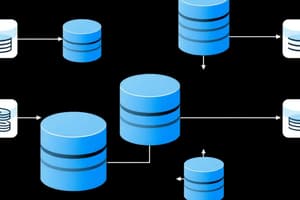Podcast
Questions and Answers
What is the purpose of supporting multiple views of the data in a database?
What is the purpose of supporting multiple views of the data in a database?
To provide different perspectives or views of the database to different users.
Why is it crucial for a multiuser DBMS to allow multiple users to access the database simultaneously?
Why is it crucial for a multiuser DBMS to allow multiple users to access the database simultaneously?
To integrate and maintain data for multiple applications in a single database.
Define a transaction in the context of a multiuser DBMS.
Define a transaction in the context of a multiuser DBMS.
An executing program or process involving one or more database accesses.
What is the role of database administrators in a database environment?
What is the role of database administrators in a database environment?
Why might some users not need to be aware if the data they refer to is stored or derived?
Why might some users not need to be aware if the data they refer to is stored or derived?
What facilities must a multiuser DBMS provide for users with distinct applications?
What facilities must a multiuser DBMS provide for users with distinct applications?
What are the three levels of schemas defined in the three-schema architecture?
What are the three levels of schemas defined in the three-schema architecture?
What does the internal schema describe in the three-schema architecture?
What does the internal schema describe in the three-schema architecture?
What is the focus of the conceptual schema in the three-schema architecture?
What is the focus of the conceptual schema in the three-schema architecture?
How does the external or view level contribute to the three-schema architecture?
How does the external or view level contribute to the three-schema architecture?
What is the goal of the three-schema architecture?
What is the goal of the three-schema architecture?
Which schema in the three-schema architecture uses a physical data model?
Which schema in the three-schema architecture uses a physical data model?
What is the purpose of the data definition language (DDL) in a DBMS?
What is the purpose of the data definition language (DDL) in a DBMS?
What is the function of the storage definition language (SDL) in a DBMS?
What is the function of the storage definition language (SDL) in a DBMS?
Why is storage definition language (SDL) typically kept separate in a DBMS?
Why is storage definition language (SDL) typically kept separate in a DBMS?
What is the role of a view definition language (VDL) in a three-schema architecture?
What is the role of a view definition language (VDL) in a three-schema architecture?
What is the purpose of data manipulation language (DML) in a DBMS?
What is the purpose of data manipulation language (DML) in a DBMS?
What distinguishes a high-level or nonprocedural DML in a DBMS?
What distinguishes a high-level or nonprocedural DML in a DBMS?
What type of query language do casual end users typically use?
What type of query language do casual end users typically use?
What form of query language do programmers use?
What form of query language do programmers use?
What kind of interfaces are provided for naive and parametric users to interact with the database?
What kind of interfaces are provided for naive and parametric users to interact with the database?
What are some examples of user-friendly interfaces provided by a DBMS?
What are some examples of user-friendly interfaces provided by a DBMS?
What is the purpose of forms-based interfaces in a DBMS?
What is the purpose of forms-based interfaces in a DBMS?
What is the advantage of using pull-down menus in Web-based user interfaces?
What is the advantage of using pull-down menus in Web-based user interfaces?
What is Data Abstraction in the context of databases?
What is Data Abstraction in the context of databases?
How do high-level or conceptual data models differ from low-level or physical data models?
How do high-level or conceptual data models differ from low-level or physical data models?
What are Representational (or implementation) data models?
What are Representational (or implementation) data models?
Which data model is widely used in commercial DBMSs?
Which data model is widely used in commercial DBMSs?
What are the two legacy data models mentioned in the text?
What are the two legacy data models mentioned in the text?
Why are representational data models sometimes called record-based data models?
Why are representational data models sometimes called record-based data models?
Flashcards are hidden until you start studying




